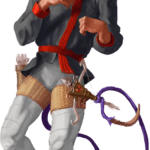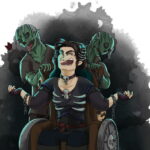Veritas Cadell

Nonbinary, it/its
Armor Class 14 (leather armor)
Hit Points 27
Speed 18 ft.
| Strength | Dexterity | Constitution | Intelligence | Wisdom | Charisma |
| 10 (+0) | 16 (+3) | 12 (+1) | 14 (+2) | 15 (+2) | 10 (+0) |
Saving Throws Dexterity +5, Intelligence +4
Skills Arcana +4, History +6, Insight +4, Investigation +6, Perception +4, Stealth +5
Damage Resistances fire
Senses darkvision 60 ft., passive Perception 14
Languages Common, Elvish, Infernal, Thieves’ Cant
Challenge 4 (1,100 XP)
Expertise. Veritas has expertise with thieves’ tools, giving it a +7 to all related ability checks, which it especially enjoys using to disarm traps.
Cunning Action. Veritas can take a bonus action on each of its turns to take the Dash, Disengage, or Hide action.
Fast Hands. Veritas can use the bonus action granted by its Cunning Action to make a Sleight of Hand check, use its thieves’ tools to disarm a trap or open a lock, or take the Use an Object action.
Infernal Legacy. Veritas’s spellcasting ability is Charisma (spell save DC 10, +2 to hit with spell attacks). Veritas has the following spells prepared:
Cantrips (at will): Thaumaturgy
1st level (1 slots): Hellish Rebuke
Second-Story Work. Climbing no longer costs Veritas extra movement, and when it makes a running jump, the distance it covers increases by +3 feet.
Sneak Attack. Once per turn, Veritas can deal an extra 2d6 damage to one creature it hits with an attack with a finesse or ranged weapon if Veritas has advantage on the attack roll. Veritas doesn’t need advantage on the attack roll if another enemy of the target is within 5 ft. of it, that enemy isn’t incapacitated, and Veritas doesn’t have disadvantage on the attack roll.
Traits
Muscle Control & Gait Difference [IE 3]. Veritas has Spastic Diplegia Cerebral Palsy and walks with a “scissor gait” (knees and thighs pressed together or crossing each other) due to inability to control its leg muscles with precision. Its movement speed is reduced by 20 percent × (IE), and it has a −3 penalty on all Dexterity (Acrobatics) and Strength (Athletics) checks and saving throws involving legs. Veritas uses forearm crutches to reduce the IE by 1.
Actions
Dagger. Melee or Ranged Weapon Attack: +5 to hit, reach 5 ft. or range 20/60 ft., one target. Hit: 5 (1d4 + 3) piercing damage.
Shortsword. Melee Weapon Attack: +5 to hit, reach 5 ft., one target. Hit: 6 (1d6 + 3) piercing damage.
Sling. Ranged Weapon Attack: +5 to hit, range 30/120 ft., one target. Hit: 5 (1d4 + 3) bludgeoning damage.
Background
While Veritas was born to a welcoming family, its community didn’t share those values. Not long after Veritas’s birth, the stigma of its infernal ancestry led to community members abducting it to be “purified” by the local clergy. Because no ritual can heal a non-existent curse or ailment, it instead led to a series of seizures that permanently changed Veritas’s body.
After rescuing their baby, Veritas’s parents fled. While they met many welcoming individuals on their travels, Veritas’s family wandered far and long before finding a community that would at least treat them with indifference.
Veritas learned about the cultures and histories of those that the family encountered, even though the interest wasn’t mutual. This broad education led to a fascination with diverse groups of people. As Veritas learned to navigate the world with curiosity and deft use of its forearm canes, its family found friends among a team of archaeologists who hired Veritas to assist them to manage supplies. As Veritas observed the team at work, its expressed interest in histories and cultures — along with its keen eye for traps and fine details in the ancient ruins — earned Veritas the respect of the team. It became a full-fledged partner and has worked with them ever since, gathering funding through research and aiding adventuring parties in (literally) unlocking the secrets of the past.
Personality
Veritas is confident in its abilities and skills, which can sometimes give others the impression that it’s being stubborn or domineering. In reality, this comes from years of experience and seeing others get hurt or fail in their goals due to ignorant or careless mistakes. Veritas has a deep reverence for ancient civilizations and wants their artifacts explored in the pursuit of knowledge, but only with respect for their creators.
Since Veritas spends more time among those who have been dead for eons than in present social circles, it may not always follow social norms, instead observing social conventions that only the oldest elves may have encountered.
Veritas’s confidence with traps can lead to a friendly deviousness; it may pretend that a disarming attempt failed, or even allow someone to get temporarily trapped, but Veritas never intentionally hurts anyone. It will do so playfully with its friends and allies, teaching them to be alert and demonstrating tricks of the trade to help them avoid trouble when it’s not around. Those who would misjudge it for its infernal heritage may find Veritas playing into their fears, trapping them and terrifying them until it can no longer keep up the ruse and then releasing them amid raucous laughter. Those who would underestimate it because of its disability will likely find themselves caught in a most elaborate trap. At that point, Veritas will give the captive audience a lecture about the ancient civilization that originated the design — and only release them once the lesson is finished.
Plot Hooks
- The party needs to find or explore a dungeon or ruins, and Veritas can help them.
- The party finds a relic or runes, and they need someone to determine their meaning.
- The party finds themselves the victims of a trap in a ruin or dungeon that Veritas was investigating and is soon rescued when it hears them.


